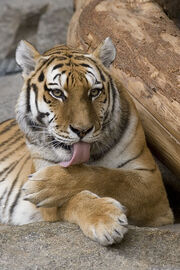Assessment |
Biopsychology |
Comparative |
Cognitive |
Developmental |
Language |
Individual differences |
Personality |
Philosophy |
Social |
Methods |
Statistics |
Clinical |
Educational |
Industrial |
Professional items |
World psychology |
Animals · Animal ethology · Comparative psychology · Animal models · Outline · Index
- For the behavior in humans see: Licking

A tiger licking its paw
Licking is a common way for animals to clean themselves. In mammals, licking helps keep the fur clean and untangled. The tongues of many mammals have a rough upper surface that acts like a brush when the animal licks its fur. Certain reptiles, such as geckos, clean their eyes by licking them.
Mammals typically lick their offspring clean immediately after birth; in many species this is necessary to free the newborn from the amniotic sac. The licking not only cleans and dries the offspring's fur, but also stimulates its breathing and digestive processes.
Some animals, such as cats, also use licking to cool themselves.[1] As cats do not sweat the way humans do, the saliva deposited by licking provides a similar means of evaporative cooling

A dog licking itself probably for grooming purposes.
Many animals also drink by licking. While young mammals drink milk from their mothers' nipples by sucking, the typical method of drinking for adult mammals involves dipping the tongue repeatedly into water and using it to scoop water into the mouth. This method of drinking relies in part on the water adhering to the surface of the tongue and in part on muscular control of the tongue to form it into a spoonlike shape.
Hummingbirds are often said to "sip" nectar, but in fact they lap up nectar on their long tongues. Their tongues have fringed edges, which help in both nectar eating and in catching tiny insects. Mother hummingbirds also lick their chicks after a rainstorm, ironically, to dry them by licking water droplets from the coats of the chicks to avoid chill.
Animals also use their tongue to enhance their sense of smell. By licking a surface, molecules on it are transferred via the tongue to the olfactory receptors in the nose and in the vomeronasal organ.
Dogs and cats use licking both to clean, and to show affection.
Primates[]
- Ring-tailed lemurs use licking as a social function, licking each other's babies within the community.[1]
- Macaques and other primates lick leaves for water in addition to dipping their arms into tree crevices and licking the water off.[2]
- Chimpanzees use licking in a variety of ways:
- Gorillas use licking in addition other senses to determine the nature of an object[6]
See also[]
- Animal drinking behavior
- Animal grooming behavior
- Animal maternal behavior
- Nociception assay
- Wound licking
References[]
- ↑ Cats and Kittens Magazine, Frequently Asked Cat Questions: Behavior. URL visited 8 April 2006.
| This page uses Creative Commons Licensed content from Wikipedia (view authors). |